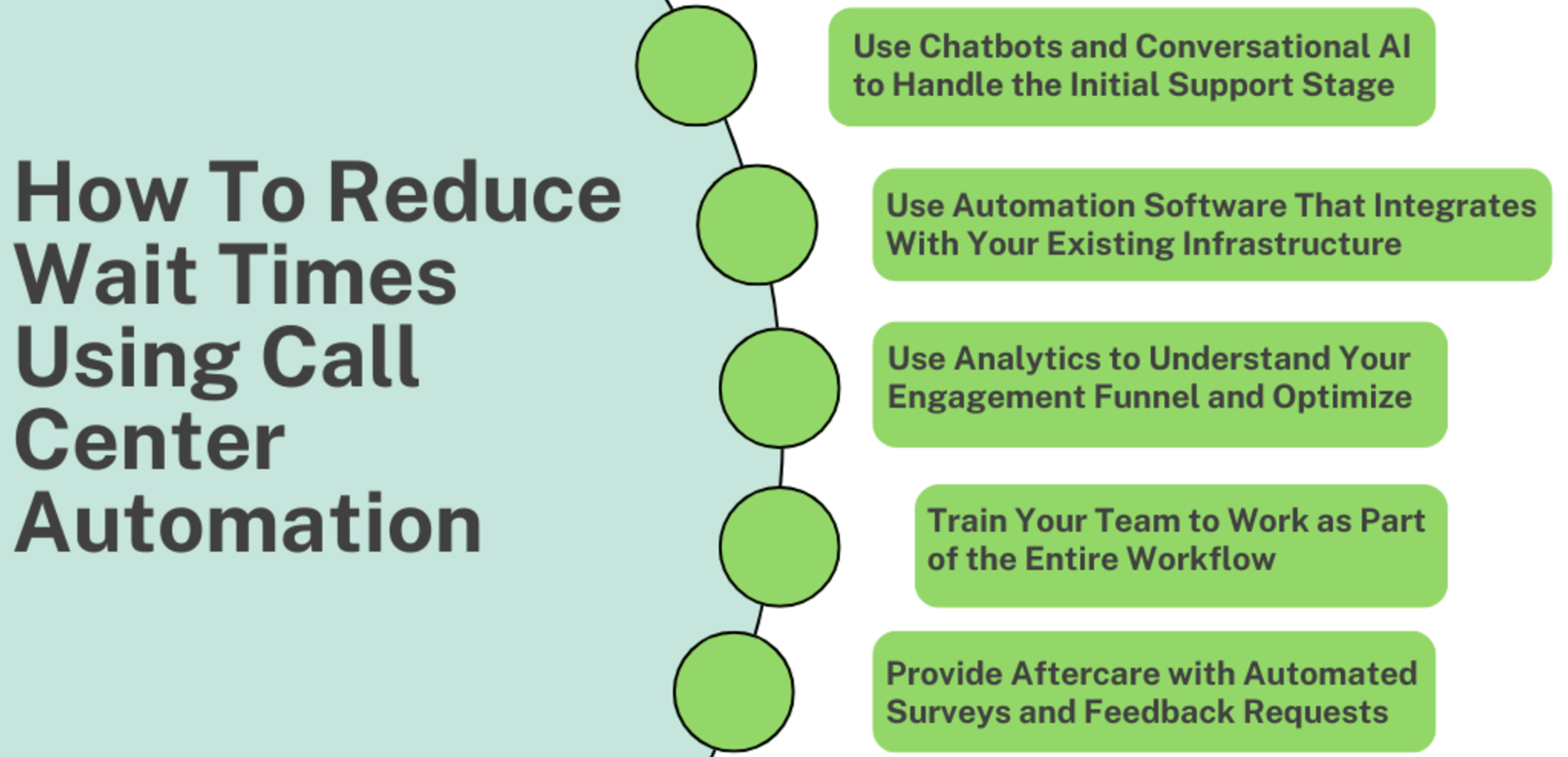Customer support is the last line of defense for your business when customers face problems engaging with your brand. Quality customer support leads to long-term loyalty and success stories for your brand.
Poor customer support experiences leave lasting negative impressions on consumers that can tarnish your reputation. The choice is pretty simple, no?
But it isn’t enough to simply want quality customer support; you have to build the team and infrastructure to deliver it. Everything from the staff you build the department around to the technology you support your team with will have a marked impact on customer experience when dealing with your business in tough circumstances.
Automation is a game-changer in the world of call center operations and is set to become the industry standard over the next few years. But what exactly does automation do in the call center sector, and how can it help with reducing wait times and increasing customer satisfaction? Let’s find out.
What is Call Center Automation?
As of 2022, 54% of customers chose the phone as their method of contacting a business for support needs, making it a crucial area for businesses to optimize — and not a moment too soon.
Whether you’re a startup shipping your first orders or a multinational organization selling at scale, automated call center technology can quickly bring a customer support center from average to excellent.
Essentially, powerful machine learning and artificial intelligence technology drive a series of automation features — chatbots, automatic call routing and screening, conversational AI, analytics, and more.
These tools offer several benefits to a call center and are designed to be flexible and scalable to the needs of your business.

Statistic sourced from statista.com.
Types of Automation in Call Centers
The main uses of automation in call centers are as follows:
IVR and IVA integration
Interactive voice response (IVR) and intelligent virtual agents (IVA) provide contextual support to customers. In some cases, they can help direct customers to call agents, and in others, they can resolve the issue with no human support needed, forming a robust AI call center.
Call agent workflow automation
Automated systems can help automate clerical work required by agents and provide instant recall of key information when a customer contacts the call center.
Forecasting and scheduling
Machine learning can identify trends in customer behavior, including typical peaks of inbound calls, and ensure you have enough staff on hand to manage demand.
Proactive messaging
Automated support can reach out to customers when business-critical messaging is needed. Some examples of proactive messaging are product recalls, service updates, and special broadcasts, to name a few.

Why Use Call Center Automation?
Call center automation should be used for one purpose — to improve the quality of your customer service. It isn’t about reducing your workforce or cutting costs; it’s an investment in future-facing infrastructure that can reduce wait times and drive the best support possible.
Below, we’ve outlined some of the key benefits of call center automation.
Reduces Load on Call Center Agents
Automated systems can handle initial contact, reducing the pressure on your support center and enabling your trained support staff to focus on complex cases and provide best-in-industry customer care.
This form of ERP transformation saves you money and time by better utilizing your human agents in key areas.
Manages Spikes of Inbound Calls Effectively
Automated systems can handle spikes of traffic more effectively than simple queue systems, reducing wait times and handling simple cases autonomously by providing initial customer support.
Supports Staff in Providing Quality Assistance
The power of machine learning helps you understand your customers better, improving your internal processes and ensuring quality outcomes for your customers.
Furthermore, your agents have the help of in-depth on-demand information — past communications, emails, and product information — to ensure they can offer quality support and manage their time effectively.

With the benefits outlined, it’s time to start integrating automation into your call center.
How To Reduce Wait Times Using Call Center Automation
The most frustrating aspect of many customer support experiences is simply the waiting itself. When customers are engaging with an agent, that means there’s progress and they’re closer to a resolution. When waiting? Well, they’re not going anywhere fast.
It’s for this reason that one of the best optimizations you can make is to ensure your customers aren’t kept on hold for too long and that any time spent waiting is still valuable. That’s where automation tools come into play.
Use Chatbots and Conversational AI to Handle the Initial Support Stage
One of the most important and essential tips we can offer is to use chatbots and conversational AI powered by robust large language models like GPT-4o. These automation tools allow you to make use of the initial call and waiting phase in several key ways.
Firstly, they can gain additional information from the customer, such as verifying their identity, understanding their reason for calling and gathering any important data relating to their purchase. This saves your agent time and reduces errors.
Secondly, they can route the customer directly to the correct department once the information has been successfully gathered and can provide accurate wait times and queue information to reduce frustration.
Finally, they can often solve simple cases without any need for a customer agent themselves. Winner!
Use Automation Software That Can Integrate With Your Existing Infrastructure
Renewing and optimizing infrastructure is a critical part of any ongoing business activity. The changing needs of your company will necessitate new technology and mainframe modernization.
Competitor activity will further drive this change. If you don’t keep up, you’ll be left behind; it’s that simple.
Fortunately, the best automation platforms have been designed to integrate into existing popular infrastructure with little hassle, making the adoption process that bit easier for you.
Consider the areas where automation can be used most effectively — initial call pickup and opening support statements, queue management, and routing, as prime examples — and integrate accordingly.

Use Analytics to Understand Your Engagement Funnel and Optimize Accordingly
As your business grows, so will the volume of customer support communications you manage. While this necessary evil is part of doing business, the increased complexity and demand on your support staff doesn’t have to be all bad.
The vast amount of information and data you receive is wildly valuable, offering a treasure trove of insights that can ultimately save you money, simplify team management, and unlock additional resources in the long run.
Analytics can identify peak hours for inbound calls, monitor the average wait time for customers, record success rates of support cases, and track a host of other metrics important to your department.
With this information, you can properly staff call centers to handle expected call volumes, ensure adequate time is forecasted for various types of support requests, and leverage the data to provide stronger and more decisive support resolutions that have proven to be received well by your customers.
Train Your Team to Work as Part of the Entire Workflow
It isn’t just about your automated tools supporting your call center agents in the background; you need to train your team to make the most of the technology available.
Educate all your team members to ensure they get the most out of the tools, and discuss the challenges they routinely have to see if automation can help them during their daily workflow.
Once they’re comfortable with the new change in process, they’ll benefit from quicker and more accurate support, reduced waiting times for customers, and a happier workforce that feels empowered to deliver the best customer service possible.
Provide Aftercare with Automated Surveys and Feedback Requests
Even after your customers have finished on a call, there are opportunities to improve. Have your automated tools gather and collate notes from the call, along with sending surveys and feedback requests to gather additional information about the customer’s experience and to confirm the problem has been successfully resolved.
While this might not seem like a direct method of cutting down the dreaded wait time for your consumers, the data you gather can be key to ensuring they won’t need to contact you again in the future.
Successful resolutions reduce repeat support demands, leading to less strain on your department and keeping the phone lines clear.

The Next Steps
Call center automation is set to become the de facto approach to large-scale customer support. Conversational AI and machine learning technology continue to mature every single day and soon will be primed to overtake human support for low-level support demands, paving the way for your customer support team to focus on challenging and unique cases.
Follow the advice in this article to implement queue-reducing processes that will ensure your valued customers receive the help they need in record time and boost the performance of your support department.
It’s a continuous journey to strive for the best call center possible, but with the help of effective automation, it is a reality you can achieve for your business.

